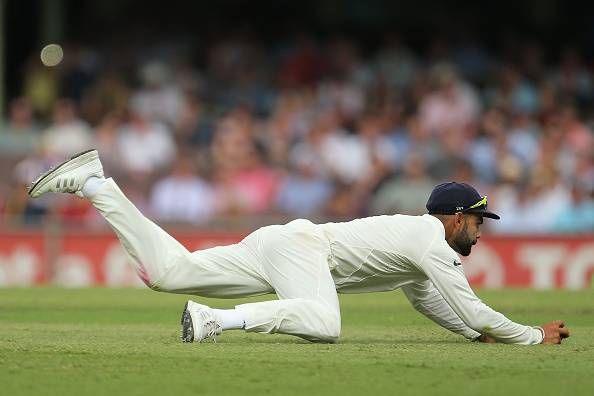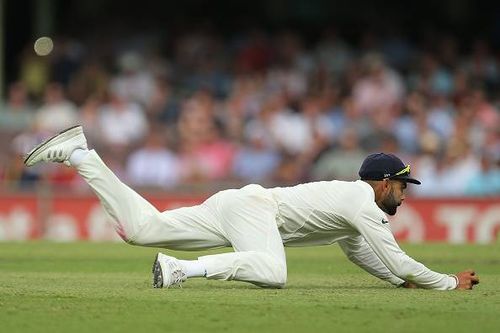
Challenges for Virat Kohli, India's new Test captain

A loss & a draw marked Virat Kohli’s first two Tests as the captain of the Indian team. Characteristic attributes of India’s leadership on foreign soil like reactive decision-making, defensive field placements, a safety-first approach and the like didn’t quite find an association with Kohli’s captaincy in that brief phase. The debut Test in this regard included an hundred from him in both the innings, while the following Test as the designated captain of the Test team featured a magnificent ton in the first innings and a significant rearguard knock to salvage a draw.
A win wasn’t achieved, but the brand was refreshing as much as effective, and there was something more than just the difference in the exuberance of a 26-year and 33-Test old against the wisdom of a 33-year & 90-Test old experienced player in MS Dhoni.
The absence of captaincy baggage permitted him to flaunt his free-spirited mind by picking Karn Sharma ahead of Ravichandran Ashwin at Adelaide, and risking a run-chase on Day 5 of the Test when most visiting sides would have settled in the pursuit for a draw. Kohli has been pretty vocal about his approach to a game recently, wherein he doesn’t mind risking a defeat for a possible win.
Thus far in his young career things are being practiced as they are preached. In the Sydney Test, the bowlers managed only 13 wickets but the batsmen exhibited commendable resolve when the runs were too many to keep the series scoreline down to 0-2.
Living up to Dhoni’s leadership
For all the positive vibes he has commanded in the short while, emulating the unparalleled legacy in Indian cricket of his predecessor would be the next big task. With 27 wins and a win-loss ratio of 1.5, MS Dhoni stands out distinctly in the list of Indian Test skippers. Only Sourav Ganguly had a better win-loss ratio (1.615) and more away Test wins (11), but the iconic image of Dhoni holding the Test champion’s mace will always remain a cherished memory.
Kohli pads up to the challenge from where Dhoni has left - the challenge of sustaining consistency in away performances. Dhoni’s last few years at the helm didn’t yield much but to be fair the old cliché of the captain being as good as his team can be a tenable explanation.
Kohli started off as the appointed skipper earlier this year, but in the true sense will be bearing the responsibility from the upcoming season onwards only. The nucleus of the team is gradually crystallizing, the team doesn’t have too alien conditions to bear with and with a healthy competition for multiple spots the new leader can buy time & space to accommodate his style of working.
Schools of captaincy
Ricky Ponting-Steve Waugh and MS Dhoni-Sourav Ganguly happen to be similar cases of two most successful Test skippers of respective teams with significantly different demeanours about them. All of them were tactically aggressive, yet for one from each pair the body languages gave away their thoughts while for the other it gave away very little.
In a naïve sense Kohli belongs to the Ponting school of captaincy; is aggressive and believes in leading from the front. The added responsibility of leading a team can sometimes outweigh the primary trade of a player or bring out the best out of him. Ponting blossomed after assuming the skipper’s hat, so did Graeme Smith and Alastair Cook and more recently Steve Smith is the new addition to this bracket.
Kohli’s temperament has been discussed and analysed extensively – some believe his captaincy may work counter-productively; although in his early years it has rubbed well on batting form.
Dhoni always remained an image of tranquillity despite harsh criticism after a string of poor performances and didn’t let that affect his decision-making or personal form. Aggression can be a two-edged sword and Kohli’s true test will only come when his combative nature goes wrong or when the team lets his plans down.
Unlike other team sports, the roles of the cricket captain & coach are considerably different. The coach’s role is largely that of man-management and playing the second fiddle to the skipper of the side. Ponting-Buchanan, Ganguly-Wright, Dhoni-Kirsten scripted some of the finest team management illustrations in the modern era. Kohli would need an able complementary companion in the locker room and thus far his partnership with Ravi Shastri seems to be working just fine.
Does Kohli have a head to wear the crown of thorns?
Some captains command the description of being ‘born-leaders’ and in most ways that is majorly true. On-field skills can be taught and improved but leading a group of varied mindsets and personalities is no textbook stuff. The likes of Sachin Tendulkar and Brian Lara were anointed in their pomp, yet the win percentages weren’t raised significantly, if anything was affected, it was their personal form.
The argument between best-player-in-the-eleven-as-skipper versus the-one-with-the-most-leadership-attributes will always carry on, but like in the past there would be a dilemma when India’s best batsman’s form becomes more important than his leadership.
The crown of thorns (as many like to call it) in the whites now has a long-term recipient, and here’s hoping that his able shoulders can bear the massive weight and reverse the trend of India’s Test performances outside the sub-continent. That his deeds can match his words.